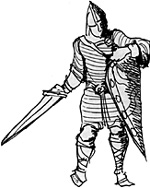At a wargaming show Midland Military in Birmingham, UK I met some people who have formed a Norman/Saxon reenactment society.They came up with a number of very interesting observations about Norman life.
 1. The armor is very heavy-I tried on a light infantry
mail (not the longer dense cavalry mail), helmet, etc.... It
weighs about 20kg (about 45lbs.) I am told. The guys said
that they had tried to climb Senlac Hill (at Hastings) last
year and found it extremely tiring. Prolonged movement or
even fighting on foot in the heavier calvary armor is very
unlikely.
1. The armor is very heavy-I tried on a light infantry
mail (not the longer dense cavalry mail), helmet, etc.... It
weighs about 20kg (about 45lbs.) I am told. The guys said
that they had tried to climb Senlac Hill (at Hastings) last
year and found it extremely tiring. Prolonged movement or
even fighting on foot in the heavier calvary armor is very
unlikely.
2. The mail gets hot in the sun.The Italian Normans very probably used coats over their armor much earlier than the crusaders. Though it may have been in the Arab or Byzantine style.
3. The kite shield is pretty comprehensive covering. A sheildwall would not suffer to much from arrows unless in close range and well aimed. Also, the arrows coming down from above would be an irritation rather than a danger to mailed troops.
4. In their experiments they found the only way a Norman calvary could attack such a sheildwall would be by holding their lance aloft and stabbing down, as you see in the Bayeux tapestry because horses would not willingly close with a hedge of spears.Thus the belief that the Normans could not use a couched lance is by this stage is probably wrong, it is more likely that they used overarmed thrusts at Hasteings out of necessity.
5. In fact, the Norman lance was not butt-weighted, which is usually necessary with overarm thrusting weapons to improve balance and reach but would be unnecessary if couched lance was the standard tactic.
6. The Norman armor has a small square (aventail?) (coif?) which is attached to the helmet and leaves only the eyes exposed. However, in the tapestry all knights are depicted as having it hang to their chests.They would not do this for extra armor protection, so either the tapestry weavers copied 'off duty' knights, or the Normans where like WWII fighter pilots and left it hanging as a rakish fashion. Miniatures of Normans with only the eyes showing would be nice.
7. The conical spangenhelm is very good at deflecting blows, and the steeper and smoother the helmet, the better it works.The reenactors reckon that the 12th century bucket helm must have evolved when fighting was primarily heavy couched lance based, as it protects the head against the lance but is a death trap in a sword fight.They noted that helmets became round or conical again in the 13th century.
8. The Norman calvary sword is shorter than the European average and infantry sword.They believe it was a close in weapon-apparently long spear plus short sword gives an advantage in melee compared to the Viking axe once contact is made.
9. The mace is a much smaller and lighter weapon than the sword, but all its mass is concentrated at one end. Apparently it is much less tiring to use, and is pretty effective but was less popular as it cannot parry blows or be used in a thrusting movement.
10. I asked about foot combat. In terms of Normans on Foot vs. huscarls, the huscarl axe is a terrifying shock weapon as even if the blade doesn't 'bite,' it will knock a man over. Against a traditional static shieldwall it would be very effective, especially against troops who were less experienced. However, against dismounted, experienced Norman knights it is a different story. Normans advance in order thrusting with long spears, closing quickly, smash shield into huscarl, out come the short stabbing swords.
 The man with the heavy axe and no shield stands
little chance.The reenactors reckon that the huscarl was
a foot shock weapon but was quickly made redundant
when good spear/sword troops became available. The
theory on why later Normans dismounted as a knight
charge comes down to the advantage held by men with
nerve and experience and a long pointed stick. A horse
won't charge a hedge of spears if the troops holding
them don't flinch.
The man with the heavy axe and no shield stands
little chance.The reenactors reckon that the huscarl was
a foot shock weapon but was quickly made redundant
when good spear/sword troops became available. The
theory on why later Normans dismounted as a knight
charge comes down to the advantage held by men with
nerve and experience and a long pointed stick. A horse
won't charge a hedge of spears if the troops holding
them don't flinch.
When asked about the difference between the Normans success and the Saxons failure with the same tactic at Hastings, they noted tha successful Norman attacks at Hastings were of combined knights and foot with mass archery support on unshielded huscarls and unarmored Fyrd (in the final scene in the Bayeux tapestry the archers are shown with huge baskets of arrows).
Back to Renaissance Ink Issue 8 Table of Contents
© Copyright 1996 by John Jay Wirth
This article appears in MagWeb (Magazine Web) on the Internet World Wide Web.
Other military history articles and gaming articles are available at http://www.magweb.com